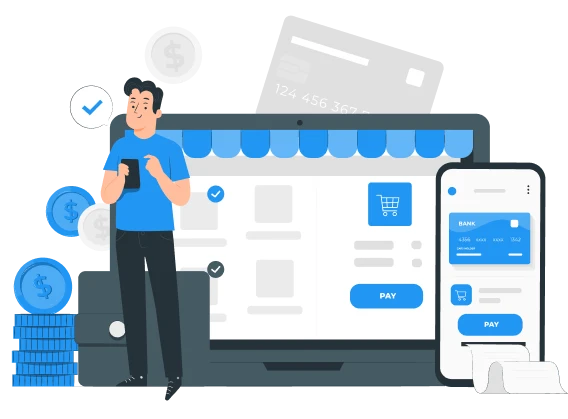Shopify
Hire Someone to Build a Shopify Store: Step-by-Step Process Guide
August 27, 2025 . 3 Mins Read


Shopify
August 27, 2025 . 3 Mins Read

Folio3, a Software Powerhouse established in 2005, is one of the leading eCommerce solution providers for SMBs and Fortune 500. The Company has expertise in diverse industries such as Animal Care, Retail, Automotive, Food and Agriculture, and Health care. From ecommerce store design and development to full-scale ERP deployment and integration, Folio3 has done it all.

BigCommerce
September 21, 2023 . 3 Mins Read
Senior Software Engineer with an experience of 7 years, having the ability to learn and collaborate in rapidly changing environments and compositions. I specialize in providing ecommerce based solutions. My expertise are around PHP | Laravel| Bigcommerce | Drupal | JS | MYSQL | Vu3 | CodeIgniter

Yashab here, experienced Sr. Software Engineer with several successful projects under my belt. I am working as a Software Engineer for over 8 years now. Specializes in multiple eCommerce platforms with Shopify App Development Certification. My technical skills are in PHP | Laravel | MySQL | JS | Shopify | BigCommerce | WooCommerce

Shopify
November 28, 2025 . 3 Mins Read
Lead UI Engineer
Lead UI Engineer & Full-Stack Developer with 13+ years of experience delivering high-quality, scalable frontend solutions across leading eCommerce and CMS platforms. Specialized in Magento, Hyvä, Shopify, BigCommerce, Wix, and WordPress. Skilled in Core Web Vitals, Performance Optimization, Responsive UI, Accessibility, and modern technologies like HTML, CSS, JavaScript, PWA, and ReactJS.
We provide a no-cost price estimate to help you make informed decisions. Get started with Folio3 and unlock expert eCommerce development services tailored to your business needs.
Choosing the right app solution for your Shopify store determines whether your operations run smoothly or become a constant source of frustration. With Shopify’s transition from private apps to custom apps in January 2022, many merchants remain uncertain about which approach works best for their specific needs. This guide breaks down everything you need to
Running an online store means regularly checking whether your platform still supports your business goals. If you are using Lightspeed and running into limits with customization, app integrations, or long term scalability, many retailers choose to migrate lightspeed to shopify as a practical next step. Shopify powers over 4.12 million active stores worldwide and offers
Running a growing e-commerce business means choosing the right platform at the right time. If you’ve outgrown Wix’s capabilities and are ready for Shopify’s advanced features, you’re likely wondering how to transfer domain from Wix to Shopify without losing traffic or search rankings. The good news? The process is straightforward when you follow the right
Making the switch from Shopify to BigCommerce represents a strategic decision for businesses seeking enhanced B2B capabilities, lower transaction fees, and greater platform flexibility. While both platforms excel in different areas, BigCommerce offers distinct advantages for growing ecommerce operations that require advanced customization, multi-storefront management, and robust API integrations. This migration guide walks you through
Switching ecommerce platforms is a major decision, especially when you’re moving from Magento to BigCommerce. While Magento offers deep customization, it comes with high maintenance costs, complex updates, and significant technical overhead. BigCommerce provides a simpler, cloud-based alternative that scales effortlessly without the constant need for developer support. This guide walks you through the complete
BigCommerce introduced its BigCommerce multi storefront feature in March 2022, transforming how businesses manage multiple online stores. This powerful capability allows you to operate distinct storefronts from a single backend while serving different customer segments, markets, or brands. As ecommerce continues expanding globally, businesses need scalable solutions to reach diverse audiences. The BigCommerce multi store
Choosing between website builders isn’t just about templates and drag-and-drop features anymore. For business leaders evaluating webflow vs wix in 2025, the decision directly impacts your team’s productivity, site performance, and ability to scale digital initiatives without constantly relying on developers. Both platforms have evolved significantly, but they serve distinctly different business needs. Webflow positions
The e-commerce landscape never stands still. What served your business perfectly two years ago might now feel like a constraint on your growth potential. If you run a Shopify store and are considering whether Wix might better serve your evolving needs, you’re not alone in this strategic reassessment. Platform migration isn’t just a technical decision,
Wix has become a cornerstone for website creation, offering users an expansive suite of tools and features to design, manage, and grow their online presence. With over 263 million users worldwide, the platform continues to evolve, integrating cutting-edge technologies like AI-driven design assistants, advanced eCommerce solutions, and personalized SEO tools. Wix users demand even more
When you’re building or redesigning your website, you’ll face a critical decision that impacts everything from your budget to your brand identity: should you invest in WordPress Customization vs Pre-Made Themes? It’s not just about aesthetics this choice affects your site’s performance, security posture, scalability potential, and long-term maintenance costs. It’s not just about aesthetics
Migrating a WordPress site can seem intimidating, especially if you’ve spent months or even years building your website. Whether you’re moving to a new hosting provider, changing domains, or setting up a staging environment, performing a WordPress website migration correctly is crucial to prevent downtime and data loss. In this guide, we’ll walk you through
Summary Market Context: Enterprise CMS platforms are shifting from monolithic architectures to composable, cloud-native solutions as organizations demand better scalability and security. WordPress Leadership: WordPress dominates the CMS landscape with unmatched ecosystem maturity, extensive community support, and proven enterprise capabilities. Cost Efficiency: Enterprise wordpress solutions eliminate expensive proprietary licensing while providing access to thousands of
The benefits of e-commerce websites for consumers cannot be ignored. These platforms provide easy, fast, and convenient shopping experiences for favorite products from any brand across the globe. Customers worldwide can purchase products and services without leaving home, saving time and money on traditional shopping trips. This convenience explains why millions of people rely on
In today’s fast-paced e-commerce landscape, website speed directly impacts your bottom line—every second counts when customers browse your online store. If your Magento site takes too long to load, potential buyers will abandon their carts before completing purchases. Magento performance optimization has become essential for online retailers who want to stay competitive. Studies consistently show
The global AI market is set to reach $757.58 billion in 2025, with Generative AI spending projected to grow by 76.4%. For Magento (Adobe Commerce) stores processing over $155 billion in annual merchandise value, this isn’t just a trend—it’s a strategic imperative. The question isn’t whether to adopt AI, but how to do it effectively.
Are you a Salesforce merchant looking for a fraud detection solution to secure your refund and payment processes? Look no further than Bolt integration with Salesforce Commerce, as it provides industry-leading fraud detection methods which help you create a sustainable, efficient, and successful business. In this blog, we will walk you through the steps needed
The world of technology is always moving forward, and businesses are always looking for new ways to improve their bottom line and streamline their operations. One example of this type of solution is incorporating Microservices and Headless Architecture into salesforce commerce cloud architecture. In this blog post, we will investigate the ideas of Microservices and
Salesforce Commerce Cloud is a powerful and versatile e-commerce platform that has become increasingly popular in recent years. It provides the ability to create powerful customer experiences, drive sales, and manage inventory all in one place. However, while it offers many advantages, challenges still need to be overcome. One of the most significant challenges is
In the dynamic realm of e-commerce, where businesses engage in intricate B2B transactions, having a seamless employee management system is paramount. Shopware, with its recent release of B2B Components, introduces a game-changing feature: B2B Employee Management. Let’s explore how this functionality empowers businesses and streamlines their operations. Understanding B2B Employee Management B2B Employee management, integrated
In the ever-evolving world of e-commerce, staying ahead of the competition requires innovative solutions and strategic planning. One of the crucial aspects of running a successful online store is having a robust Content Management System (CMS). Shopware, a leading e-commerce platform, offers extensive CMS capabilities, ensuring that your online store operates efficiently and delivers an
E-commerce has evolved significantly over the past few years, and with it, the tools and platforms that businesses use to power their online stores. Shopware, a leading e-commerce platform, has continually been at the forefront of this evolution. Their latest offering, Shopware Enterprise, aims to provide businesses with a robust, scalable, and feature-rich solution to
Ecommpay, a leading end-to-end payments platform for ecommerce, has joined forces with BigCommerce, a powerful open SaaS ecommerce platform. This strategic partnership aims to provide UK and EMEA merchants with a comprehensive payment solution designed to optimize conversions, reduce costs, and ensure secure transactions. The integration offers several key benefits for businesses: – Cost Savings:
This blog post will provide CTOs and ecommerce store owners with valuable insights and practical tips from industry experts on how to maximize their ecommerce store’s conversion rate. By covering various aspects of conversion rate optimization, website design, user experience, persuasive copywriting, mobile optimization, personalization, and more, readers will gain actionable strategies to improve their
The impact of AI in ecommerce has been significant in recent years. As a result, it is crucial for CTOs to understand how AI affects their business operations. The blog explores the role of AI in ecommerce, including its applications and examples such as chatbots and personalized recommendations. CTOs need to keep up with AI
Send in your details to get instant access to our calendar and book a convenient slot.
Please ensure to send sufficient details about your project so our experts can provide you the most value in the free consultation.
Subscribe Newsletter
Join our mailing list to receive updates from our team
2–105 CONSUMERS DRWHITBY ON L1N 1C4
Amado Nervo #2200, Edificio Esfera 1 piso 4, Col. Jardines del Sol, CP. 45050, Zapopan, Jalisco, Mexico
C/- Prime Partners Level 4 1 James Place, NORTH SYDNEY New South Wales 2060
160 Bovet Road, Suite # 101, San Mateo,
CA 94402 USA
6701 Koll Center Parkway, #250 Pleasanton, CA 94566
Tel: +1 408 365 4638
Export House, Cawsey Way, Woking, Surrey, GU21 6QX
Tel: +44 (0) 14 8339 7625
Folio3 FZ LLC, UAE, Dubai Internet City,
1st Floor, Building Number 14, Premises 105, Dubai, UAE
Tel: +971 04 2505173
49 Bacho Kiro Street, Sofia 1000, Bulgaria
Folio3 Pvt. Ltd, Folio3 Tower, Plot 26, Block B,
SMCH Society, Main Shahrah-e-Faisal, Karachi.
Tel: +92-21-3432 3721-4
First Floor, Blue Mall 8-R, MM Alam Road Gulberg III, Lahore
Corporate 7 by Maaksons, Executive Block, Civic Center 1, Gulberg Green, Islamabad
Tel: 0333 5657425